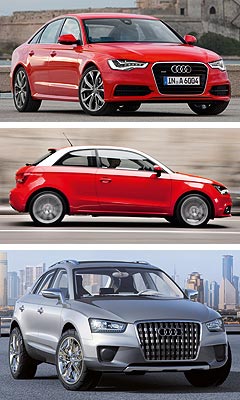New models to ride Audi’s January sales wave
BY HAITHAM RAZAGUI | 14th Feb 2011

The A7 Sportback – Audi’s answer to the Mercedes-Benz CLS and Maserati Quattroporte is confirmed for Australian release in March with a two-engine opening line-up comprising a 220kW 3.0-litre supercharged petrol V6 and 180kW 3.0-litre twin-turbo V6 diesel, both driving all four wheels through Audi’s S-tronic seven-speed dual-clutch transmission.
As GoAuto has reported, the A6 sedan – which will make its local debut at the Melbourne motor show in July before hitting Australian showrooms – will be powered by the same engines as the A7 with the additional choice of a 150kW 2.8-litre naturally-aspirated petrol V6. All A6 and A7 launch engines will come equipped with fuel-saving idle-stop technology.
Around the same time as the A6 launch, Audi will plug a gap in the A1’s range with the debut of a 1.6-litre diesel variant offering Prius-beating fuel consumption of 3.8L/100km and sub-100g/km CO2 emissions.
Audi Australia product planning general manager John Roberts told GoAuto at the A8 TDI launch that it was “a case of when rather than if” the A8 range will receive a hot S8 variant, most likely powered by a twin-turbo petrol V8 that will also go into the next RS6 in a downsizing exercise to replace the Lamborghini-derived V10 fitted to previous-generation models.

Asked if these models will make it Down Under, Mr Roberts replied: “When you look at the S model strategy, the model line, it’s a yes”.
Looking further ahead, Mr Roberts cited a 2012 arrival in Australia for Audi’s BMW X1-rivalling Q3 SUV but in contradiction to previous reports, an Australian release of the hybrid Q5 – which is yet to be confirmed for right-hand drive production - now looks shaky.
“It is a case of if we can get it,” said Mr Roberts.
Unfortunately for hot Audi fans, the RS3 definitely won’t be coming to Australia either. Audi Australia says it has been released too late in the donor A3’s product cycle and would sell in insufficient volumes for it to justify the investment in ADR approval fees.
“The RS3 won’t be coming to Australia in its current generation,” Audi spokesman Sean Poppitt told GoAuto.
“There is a specific ADR regulation that applies only in Japan and Australia that at present the RS3 does not meet. With the current A3 being relatively late into its model cycle, it does not make any sense to re-engineer the car for a small-volume market such as Australia.”The company is aiming for a success-breeds-success approach by encouraging investment by dealers to take the brand further.
Speaking at the launch of the A8 TDI range, Audi Australia managing director Uwe Hagen said: “We were able with this growth rate to convince our dealer network to invest into the brand so more or less we have a completely new network and the dealer network has invested $220 million into the future.”So far this has manifested most obviously in the construction of Audi’s ‘terminal’ dealerships, the first in the world being the $12 million Audi Five Dock building in Sydney. This was followed in 2009 with the $50m ‘lighthouse’ dealership that also houses Audi’s Australian headquarters. Last year, another ‘terminal’ dealership opened for business in Parramatta NSW at a cost of $9 million.
Audi’s Australian sales overtook those of Lexus in 2008 and have continued to increase significantly since then, while BMW’s figures have remained almost static by comparison and Mercedes-Benz fluctuated between growth and decline.
In fact, Audi has experienced just one year of drought since 1996, when sales dived from 4450 in 2003 to 3701 in 2004 before rebounding 29.9 percent to 4808 the following year.
The following two years broke the 20 per cent barrier. With a peak of 30.2 per cent growth in 2008, the GFC went apparently un-noticed for Audi, whose growth rate dropped back to 20.2 percent and 14 per cent in 2009 and 2010 respectively.
The company’s total growth since 2004 stands at 248 per cent and last year it delivered 12,900 cars in Australia, followed by a record-breaking January in which it trounced BMW by 470 vehicles and traditional premium vehicle leader Mercedes-Benz by 510 sales.